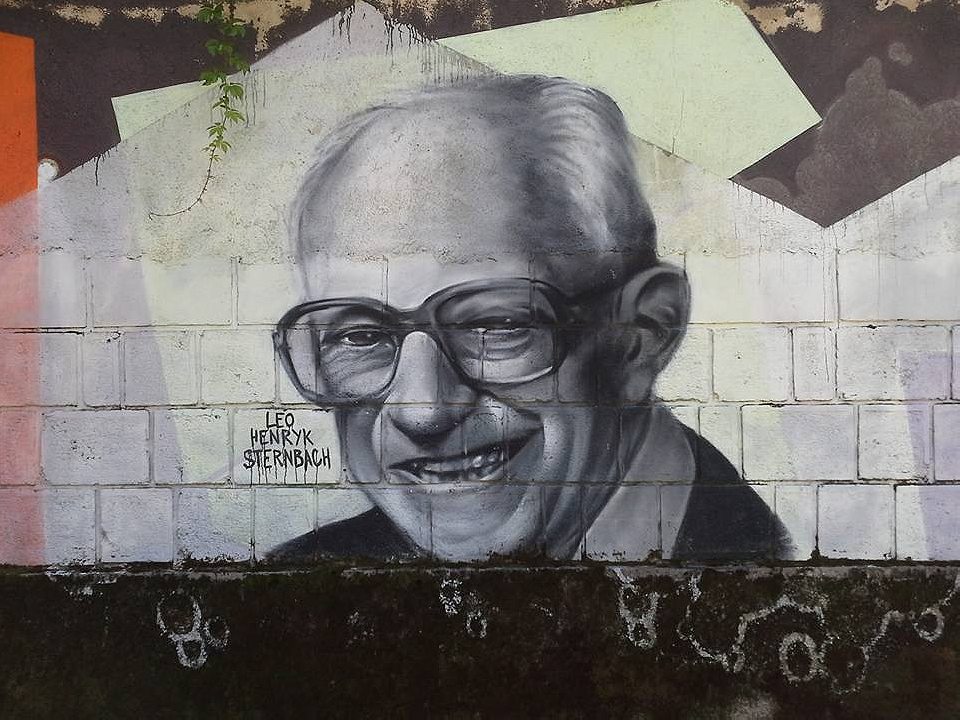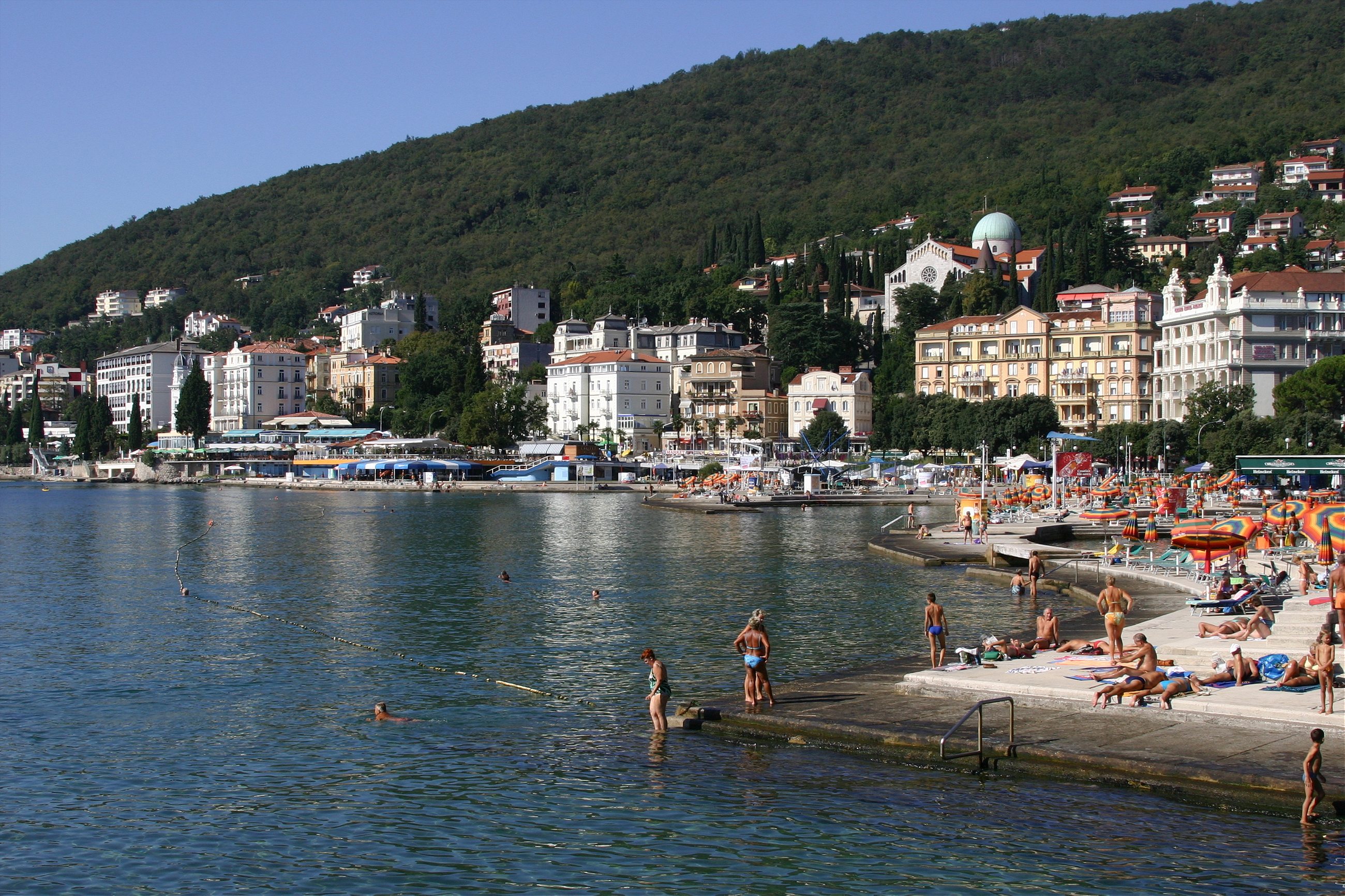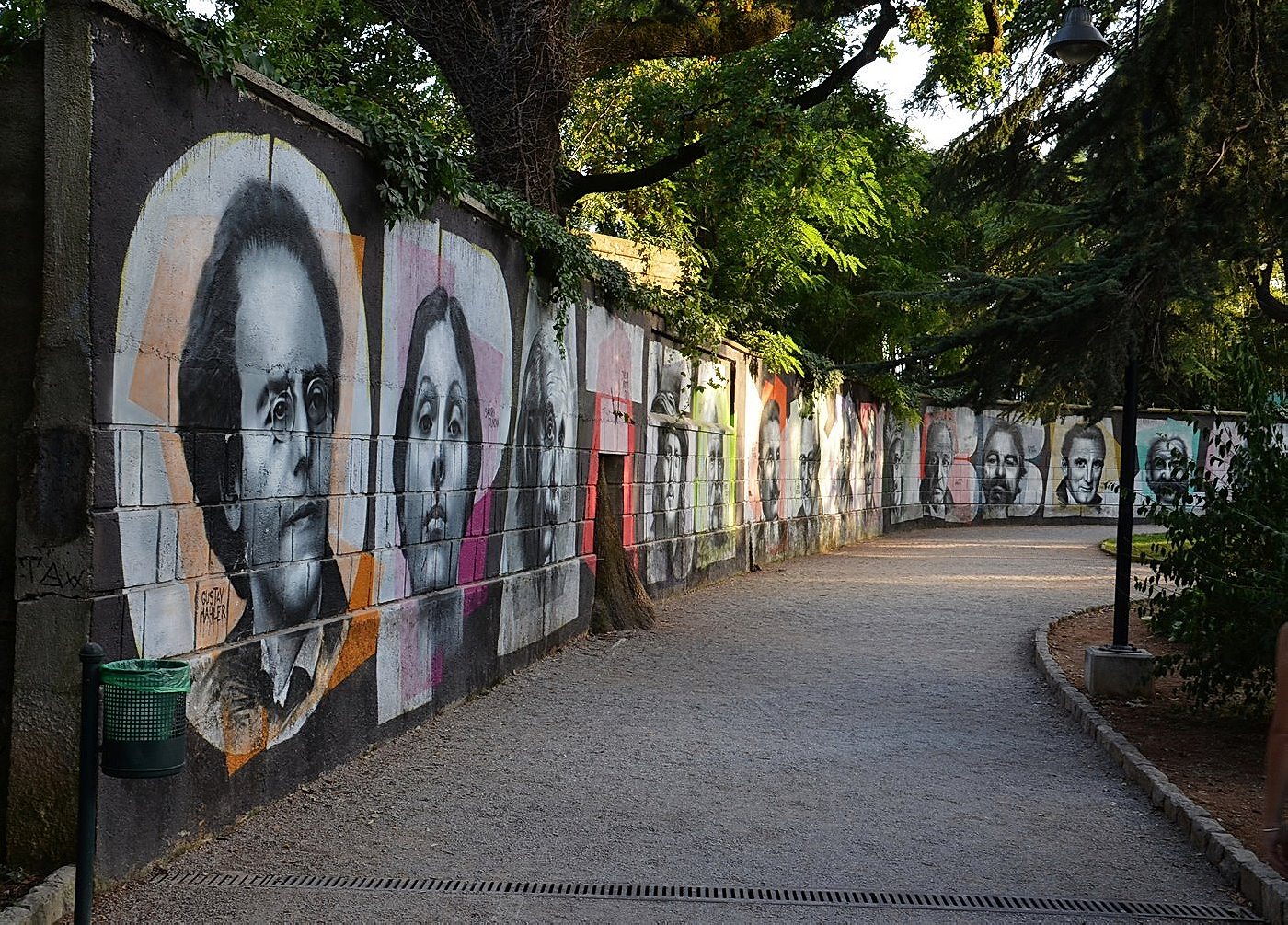A self-described “benzo historian” and former addict visits the unlikely spiritual home of Valium in Croatia.
To go eye to eye with Leo Sternbach in Opatija—and I’d come to the Croatian town for just that purpose—I had to break the law. I knew that the infamous mural is in the city park, Park Angiolina, a wooded expanse of several hundred acres, but I didn’t know exactly where in the park. I didn’t want to know. I wanted to let the encounter unfold in its own time, unforced, happily accidental. Birdsong punctuated by an occasional human voice (it was early June and just at the beginning of the tourist season) accompanied me along the winding paths shadowed by species of trees from nearly every country on the planet; like the gardens of the Vatican, the theme of Park Angiolina is international diversity, a showplace of imports each with its own plaque describing how far from home and how much out of its element.
Then I found Leo Sternbach, on the other side of a tall, orange, mesh plastic construction fence: the inventor of Valium had been fenced off for the time being. I hadn’t traveled all the way to Opatija to view Leo Sternbach through plastic mesh, so I understood immediately that I would need to trespass. The thought ran through my head that I could seek out permission from the proper authorities in Opatija. But I was already just a few feet away, and I’d traveled so far. I forcibly parted a joining in the mesh and slipped through. The path on the other side was muddy and unkempt all along the mural; someone, though, had taken the trouble to lay down wooden planks to allow an unhurried communing with Leo Sternbach that did no damage to the restoration-in-progress of the path. Some other benzodiazepine pilgrim, no doubt.

I’d wanted to visit Opatija ever since my addiction physician sang its praises as a holiday destination. She’d visited out of professional curiosity—her specialty is benzodiazepines, as, in a different way, was mine—and afterward she went back every August with her family, renting a villa in the hills. Off she went one August, saying goodbye to me forever, a pleasant goodbye as we were also saying farewell to my addiction to Sternbach’s creations.
Now that I was here, I could see the appeal for some standard vacationer seeking peace and quiet who’d never forged an prescription or suffered through withdrawal tremors. The town is miniature in comparison to its more well-known Adriatic cousins to the south, Split and Dubrovnik. Hotels and villas built in the 19th century line one side of the picturesque thoroughfare around which Opatija is oriented; looming above the pastel Riviera architecture are laurel forests with their walking paths named after monarchs and the consorts of monarchs. A seaside promenade, the Lungomare, brushes up against marinas, beaches, and open-air cafes as it wends for seven miles from an endpoint in Old Town, where—on the steep streets too narrow for automobiles—Leo Sternbach, over a century ago, conducted his first experiments in chemistry (rocketing tin cans high into the air by igniting a mixture of calcium carbide and water).
It’s not as if Opatija plays itself up as the birthplace of the inventor who brought benzos—the colloquial name for a class of drugs most commonly marketed commercially as Valium—into the world. The invention was monumental, yet, until recently, no monument to Leo Sternbach existed in Opatija. Actually, there’s still no formal monument, merely a small engraved sign on the patio of a pizzeria that now occupies the ground floor of the house where Leo Sternbach spent his childhood.
During the busiest weeks of the season, the wait for entrance into the pizzeria can be an hour or more. The tourists in line aren’t there to pay homage to the birthplace, however. The owners of the pizzeria themselves weren’t aware, when they bought the building, of its historical significance, its role in the lineage of the benzodiazepines. This birthplace obliviousness is both commonplace and striking in Opatija.

Sanja Simper is the force behind the tribute to Leo Sternbach at Pizzeria Roko. In 2006, Simper and her students—she teaches at a high school around the corner from the pizzeria—began a project on the history of Opatija, which eventually resulted in an international conference on the state of benzos, held in Opatija; both the conference and the tribute were financed by Hoffmann-La Roche, the Swiss pharmaceutical giant for whom Leo Sternbach worked when he invented Valium. Simper has a doctorate in modern European history. She’s lived in Opatija since she was three years old. But it wasn’t until the school project in 2006 that she discovered where the inventor of Xanax and Klonopin and other benzo household names had been born.
One evening, Simper and her husband, Alex, led me on a short walking tour of the major benzo landmarks of Opatija. We started, naturally enough, at the pizzeria, then strolled down to the park where, trespassing for a good cause, we admired the mural that features Leo Sternbach along with other Opatija-related luminaries. To Leo Sternbach’s left is Andrija Mohorovičić, considered one of the founders of modern seismology. (Another outstanding pizzeria in Opatija—and this writer does not give praise to pizzerias lightly—is the Pizzeria MOHO, named after the seismologist.) Farther down the mural can be found luminaries with less obvious ties to the city: Isadora Duncan (visited Opatija at the height of its fame as a resort) and Gustav Mahler (ditto) as well as Kirk Douglas and Robert de Niro (later visitors).

We walked past the former site of the Sternbach family pharmacy, where Leo Sternbach’s father had invented Laurol (a multi-purpose skin ointment) and Ovol (lozenges used in treating malnutrition), the first of many Sternbach contributions to medicine. Simper showed me a vintage postcard of the building as it once had been, a colonnaded marketplace: now it was the ramshackle, and defunct, Café Paris. The school a few blocks up from the pharmacy was still intact, but uncommemorated, lacking even a simple inscription such as “Here began the education of the benzo hero, Leo Henryk Sternbach.”
And so ended the tour: we’d reached the last of the landmarks. I said goodnight to Simper and her husband and returned alone to Leo Sternbach’s birthplace, where I asked a friendly server on the patio whether it was annoying for him to constantly field questions from inquisitive benzodiazepine pilgrims. The server said that he’d only fielded one such question in the past, from a German journalist. I asked if it might be possible to discreetly take a look around the second floor, or at least walk up the stairs, to at least glimpse from the outside the apartment where the Sternbachs had lived when Leo was a child. At night, Simper had explained, a bell rang in the apartment if a customer hurried to the pharmacy with an emergency. The echo of that bell, I think it can be fairly said, resounds through the decades of becalming via pharmaceuticals. The server told me that a visit might be possible, as the current tenants (a gynecologist based in Oslo and his wife) were out of town. But first I would need to speak with the owners of the pizzeria.
The story of Opatija is really a story about health tourism
To appreciate the curious absence of Leo Sternbach from the tourist landscape of Opatija, it’s worth noting that Valium, the second anxiolytic drug invented by the chemist—the first was given the unfortunately Orwellian name Librium—topped the charts for prescription sales in the United States for 13 years (!), and its successors, the aforementioned Xanax, Klonopin, and others, haven’t done poorly for themselves either. Over 39 million prescriptions were written just for Xanax in the U.S. in 2015. Benzodiazepine popularity is hardly exclusive to the U.S. In fact, Croatia, in 2012, ranked second worldwide, after Ghana and just ahead of Macedonia, in per capita daily dosage of diazepam (the generic form of Valium).
The slighting of Sternbach is even more egregious given that medicine and health are what put Opatija on the map. “The story of Opatija is really a story about health tourism,” wrote Amir Muzur, a former mayor of the city, in his introduction to a museum-style sequence of informational panels displayed in a corridor of Opatija’s largest medical clinic. Muzur also happens to be a medical doctor who teaches at the nearby University of Rijeka. I couldn’t read much farther than that first sentence, however, because the corridor seemed designed to thwart the casual historian interested in health tourism: it connected hot baths at one end with a sauna at the other, and the air in the corridor itself must have been approaching 150 degrees Fahrenheit.
Still, health tourism past and present is evident nearly everywhere in Opatija, including my hotel, which had been built, in 1912, by the Association of Hungarian Typographers as their own personal health spa on the Adriatic. By far the most prominent feature of my hotel’s parking garage is a glossy billboard advertising affordable dental veneers and implants. (According to Alex Simper, Sanja’s husband, whose background is in tourism and hospitality, Croatia has risen as a dental holiday destination because of the high level of training of Croatian dentists and the use of high-quality, Swiss-made materials.) All along the seaside promenade, where health tourists once took their constitutionals, stand hotels formerly purposed as spas or sanitoria. Infirm Austrians and Italians and Germans once flocked here to be cured by various forms of bathing. Electric baths had their heyday (bathers were spared electrocution through an insulating barrier of porcelain), as did cold baths and baths infused with everything from sand to Norwegian algae.
Opatija’s flourishing culture of health tourism was, in fact, the reason that Leo Sternbach’s father moved there from Poland at the turn of the century to establish and operate a pharmacy. Those informational panels installed by the city emphasized the success of Laurol, Michael Sternbach’s invention, but they relegated his son’s benzo achievement to a parenthesis.

It wasn’t until my last morning in Opatija that I sat down with the Dunatovs next door to the pizzeria. Stjepan Dunatov is a chef who trained in Zagreb. He and his wife Elizabeta bought two adjacent buildings in Opatija and turned the first floor of each into a restaurant, discovering in the process that they’d acquired the birthplace of the Klonopin creator. I asked them whether they ever grew weary of being bombarded by inquiries from self-styled benzodiazepine historians, and they gave me the same answer as the server next door: I was the first. Regarding the Valium pizza on the menu next door—tomato, mozzarella, prawns, salmon, rocket, garlic—the Dunatovs deflected the credit for the idea to the pizza chef. The Margherita outsells the Valium by half, they said.
I kept looking for an opportunity to broach my wish to visit the historic apartment next door; the Dunatovs kept plying me with food. My plan had been to head west after leaving Opatija and visit friends in Venice; Stjepan and Elizabeta shook their heads and said no, I absolutely must go south. They plotted out an itinerary of restaurants and islands. First I would need to extend my stay by one night in Opatija and visit the restaurant Navis, which Stjepan spoke of with awe. Then a short drive south to Zadar, a seaport where chefs have been putting fresh fish on the table since the Stone Age, and where it would be sinful not to drop in at Bruschetta; after that, a 20-minute jaunt by boat would take me to Preko on the island of Ugljan. I could spend a week on Ugljan exploring the menu at Roko Konoba, also owned by the Dunatovs. As Stjepan planned my trip, he issued instructions to the server, who continued to bring us dish after dish from the kitchen. There had been a time a few years before when I’d become addicted to a benzo in such huge quantities that I became gaunt, when even my lifelong favorite foods left me indifferent. I didn’t mention this era to the Dunatovs, and watching me keep pace with the bountiful medley of arriving dishes, I’m sure they never would have guessed.
Top image: Ronnie Macdonald